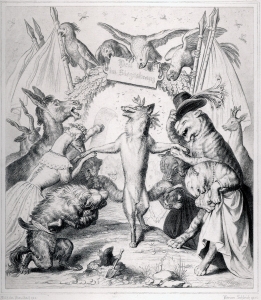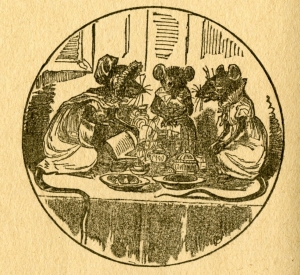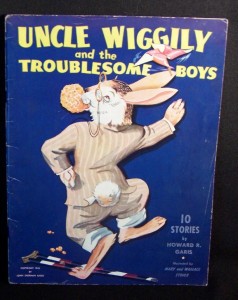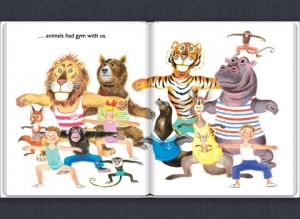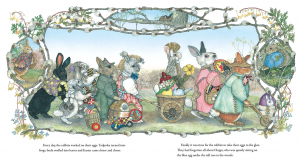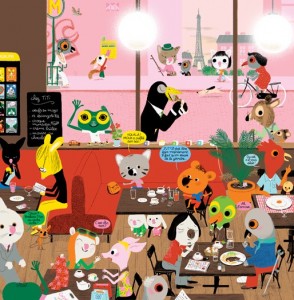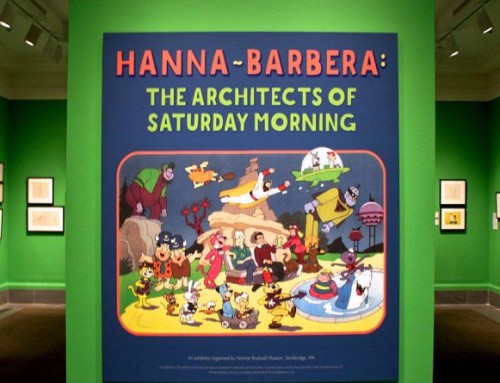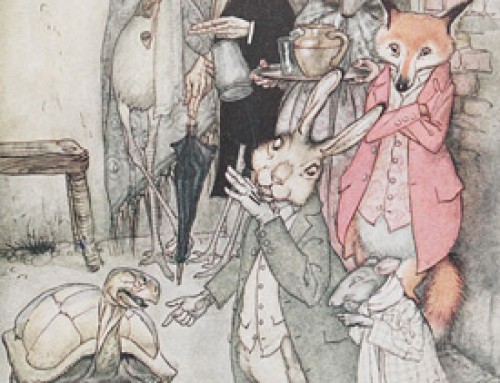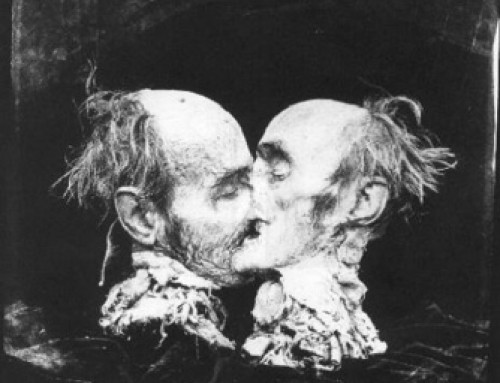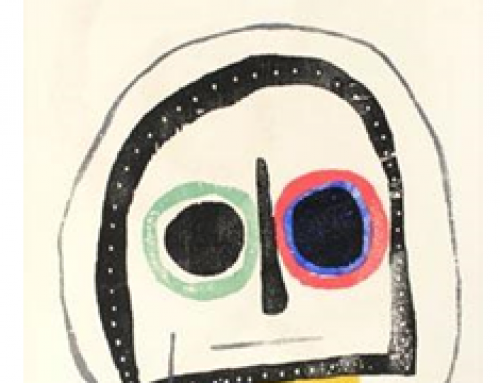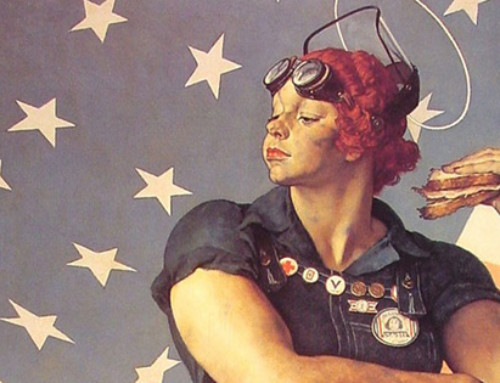By Megan Jones, grad student MICA’s MFA Illustration Practice, Fall 2013, Critical Seminar Final Paper.
Everyone at one point or another in their lifetime has talked to their pet as if it was a person. We name them, groom them, let them live in our homes, and sometimes pamper them as if they were our children. As human children grow up observing these behaviors, they reflect these tendencies and begin expanding upon them with their creativity and play. Dressing up the dog, and going on space adventures with the cat are acceptable behaviors in the mind of a child. At the end of the night, being read a bedtime story often involves an animal character that could be doing everything from baking cookies to exploring new and alien worlds. Children’s literature is a ripe field for anthropomorphism because of this enthusiasm for new adventure with interesting characters. Anthropomorphism throughout history is representative of the artistic tastes that the adults prefer, while still maintaining a level of whimsy that leaves the door of open for future exploration.
Anthropomorphism, being defined as ‘an interpretation of what is not human or personal in terms of human or personal characteristics’, has been explored since the believed birth of art, where hunters created sculptures of human figures with lion heads approximately 30,000 years ago, advancing into the development of complex cultures and religions, such as the Egyptian pantheon of gods and goddesses, to more modern times across the world, including the Kwakiutl tribe of the Kwakwaka’wakw people and their Raven transformation ceremonies. From illuminated manuscripts to needle crafts, the act of humanizing animals has been a player in the development of modern culture. Animator and author Paul Wells believes that anthropomorphism is used as “ an interrogative tool
Figure 1. Wilhelm von Kaulbach (1805-1874).
As civilizations turned into unique cultures, many traditional stories and myths, which had been passed down from generation to generation, began to be printed in books. With the advent of printing presses and larger production runs, books became increasingly accessible to those outside of the elite. Children’s illustration between the Rococo and Baroque periods all the way up to the 1900s was often created using etching techniques, since this was the most readily available and reproducible of the media at the time. Artists like Johann Elias Ridinger (1697-1767) and the much later Wilhelm von Kaulbach (1804-1875) (fig. 1), illustrated imagery from nature and portraiture of members of high society, but also explored the personalities that we as humans place upon animals. Their plates often depicted wild animals in pastoral or scenes of daily life. During this period in history dogs and cats were in the early stages of modern lap pets, and often seen as symbols of status and wealth, where the tiny and distorted became fashionable and cute. As more and more animals were being introduced to homes, people began identifying and personifying the animals that shared their habitats. When the human home becomes the environment for pets seen as anthropomorphic characters, that is where the evolution begins to speed up.
Figure 2. Palmer Cox (1840-1924). Grandmother Mouse Tale. 1896.
With the ending of the 17th century, new artists were beginning to develop their careers along with the creation of new processes in which to display their work to the masses. Artists such as Palmer Cox and Beatrix Potter were working at the turn of the century, while the avenues began to expand in new ways. The availability of children’s books was beginning to expand more to the masses, thanks to new printing technology, and because of this more children had the opportunity to explore using their imaginations. Artists had the choice to reference classical literature or explore new directions as they reacted to the world around themselves. It should be noted that as art transitioned from the 16th to 17th century, degrees of anthropomorphism began to move in unique directions. No longer animals were those who merely talked or walked divided between two or four feet, creatures began wearing clothes, living in homes and having complicated family structures develop. Palmer Cox’s Grandmother Mouse’s Tale centers around a community of mice living in a farmhouse and their miniature habits, lives, and rituals as they attempt to avoid traps, the cook and the cat. The story for which the book is named, revolves around a grandmother mouse explaining their family history, to her granddaughters under a cabinet, including how their grandfather had passed away after eating rat poison (fig. 2). Beatrix Potter created family dynamics in each of her popular tales that contained characters such as Squirrel Nutkin or Tom Kitten. The Tale of Peter Rabbit for example, tells us the tale of a young rabbit whose childlike abandon overtook his fear and common sense and was almost was killed by Mr. McGregor in his foolhardy exploration of the lush garden. When Peter goes home, having lost his clothes in the fence in a mad dash for safety from the basket of Mr. McGregor, his well-behaved sisters get a porridge dinner while he lies exhausted in bed. While both of these universes have developed the anthropomorphism of the animals involved, the world in which they live is still dominated by humanity. These creatures seek to live off the scraps of the higher power that is man, and their lives revolve around the risks involved within the proximity in which they live.
Figure 3. Mary (?) & Wallace Stover (1903-1983). Uncle Wiggily and the Troublesome Boys, 1943, by Howard Garis.
After the turn of the century, from World War I and on, as we inched closer toward World War II, the marketplace begins expanding and anthropomorphic children’s books and board games are seen more readily. A good amount of this forward progress is thanks to the Uncle Wiggily series by Howard Garis (fig. 3). Over the course of 30 years this series, which centered around the adventures of a silly rabbit and his friends, included 79 books and numerous games. The artists are changed frequently, and depending on the time frame in which the book was published, it may have been completed by the likes of Lansing Campbell, Louis Wisa, or Mary and Wallace Stover among others. The Uncle Wiggily series and its contemporaries illustrate the next advancement in the evolution of anthropomorphism in children’s literature. Instead of being animals living in fear of humans, this world has in fact moved to the point where humans are unnecessary for the story, so they are removed. Thanks to previous generations, children have begun to think more creatively, and are more likely to grasp the ideas involved in a purely animal setting. This expunging of humans begins a new chapter in children’s literature, no longer being held back by the constraints of our own reality, authors and illustrators have the opportunity to effectively create new universes for their characters to play in. Alice and Martin Provensen, the artist and creators of The Color Kittens, used this option in developing a picture book for the Little Golden Book series whose theme was purely color theory. As two brother kittens haphazardly mix paint colors, they inadvertently create a world in which to live. A friend and contemporary of the Provensons, Richard Scarry, became famous for the world that he built for his characters to inhabit. Though Scarry did a number of freelance books, including numerous Little Golden Books, the creation of the Busy Town franchise is what solidified his place in history. Not only was this world populated with animal people, but the details of a working society were used to create open ended books that could continue in numerous directions and also serve as inspiration for the countless spin off books, TV series, and games that were to follow. Fellow artistic contemporaries of Scarry included Tibor Gergely and Maurice Sendak, both of whom played with the same concepts as Scarry, but allowed humans to sneak back into and intermingle in their worlds. In Animal Gym by Beth Greiner Hoffman and illustrated by Gergely, animals and humans of all sizes and shapes work out in the same facilities (fig. 4) and in Sendak’s Little Bear series, visits Little Bear and his animal friends in the woods for adventures and sometimes life lessons about growing up.
Figure 4.Tibor Gergely (1900-1978). Animal Gym, 1950s, by Beth Greiner Hoffman
All of these artists are reflections of their times. In the 1960s, people were searching out forms of self-expression without limitations. As the art world continued to increase in size and scope, a wider variety of styles began to develop. Companies began to seek out artists who could emulate the level of fame that Sendak and Scarry had achieved. An example of a series that is running successfully across decades, is the Berenstain Bears. Created by Stan and Jan Berenstain, the series is still being produced to this day, thanks to their son Mike Berenstain who has taken over the series after the deaths of his parents. While some series adapt and change with the times, the Berenstain Bears have remained fundamentally the same throughout their lifetime, spare the design, which was adapted to echo the styles popular to the decade it that it resided. One reason that the series was so successful was that the family echoed that of the nuclear family: Mother, Father, and children, living a harmonious life. The bear cubs often experienced life lessons that any young child could relate to, and often emulate. In some ways, companies can be thankful for series such as these, lasting as they are. Thanks to the overwhelming amount of work and money that was generated within these, artists had more luxury to play within the realm of anthropomorphism and as we begin to approach more modern times, a new shift is occurring.
Figure 5. Jan Brett (b. 1949). Image from The Easter Egg, 2010.
Anthropomorphic children’s literature up to this point has followed a system of continual advancement toward humanizing the animal. It started with Ridinger and Kaulbach’s animals that occasionally conversed and stood on their hind legs, to Palmer Cox and his human fearing animal people, up to the worlds of Scarry and Berenstain, where humanity in the sense of Homo sapiens, is unknown. It is at this point that artists begin to have diverging thoughts of where anthropomorphism should lead. As more and more artists crowd into a small market, the path is shattered into many different reflections and categories. This mimics the postmodern fine art world today as well; anything has the opportunity to be perceived as excellent at any given point. Many amazing new talents have begun to appear alongside hardened veterans who attempt to keep a sense of normalcy while still remaining relevant to the shifting times. Jan Brett, whose picture books have been popular since the 1980s, is continuing a tenuous grasp on her corner of the market; where people still are attracted to realism and traditional skills (fig. 5), and animals are closer to the vein of Ridinger to Beatrix Potter, sometimes featuring talking animals, and others dressed in clothes within small worlds. The full-page paintings that are her illustrations are intricate, down to the borders and character designs, which show that she has spent years researching the animals she depicts. In contrast, Marc Boutavant’s little animals with gigantic heads (fig. 6) are reminiscent of early Richard Scarry, with brighter, more vividly painted flat colors that graphically create scenes of daily life and play.
Figure 6. Marc Boutavant. Image from Around the world with Mouk, 2009.
Though many more artists could be mentioned to describe the variety of styles present in the current marketplace, such as Jon Klassen, Ursula Vernon, and John Manders, the works of Boutavant and Brett succinctly illustrate the range that is possible. In a general sense, as the world population has increased, so to has the variety of possible outcomes and artists to fill the needs. In any section of the market, it is possible for any particular style to be relevant and represented. As the world moves forward, and we continue to explore new avenues for anthropomorphism in art, it will be exciting to see what develops, be it realism or abstracted, traditionally painted or digital. The important thing is that children continue to enjoy and learn from these interesting animals and the worlds they inhabit.
Works Cited
Cox, Palmer. Grandmother Mouse’s Tale (and other stories). (New York: Hurst & Company, orig. 1896, 1902)
Potter, Beatrix. The Tale of Peter Rabbit. (London: Frederick Warne and Co. Ltd., orig. 1902, 2002)
Rettan, Walter, and Ole Risom. The Busy, Busy World of Richard Scarry. (New York: Harry Abrams, Inc., 1997)
Salisbury, Martin. Play Pen: New Children’s Book Illustration. (London: Laurence King Publishing Ltd., 2007): 14-15.
Wells, Paul. The Animated Beastiary: Animals, Cartoons, and Culture. (New Brunswick, N.J.: Rutgers University Press, 2009) eBook Collection (EBSCOhost). 96.


